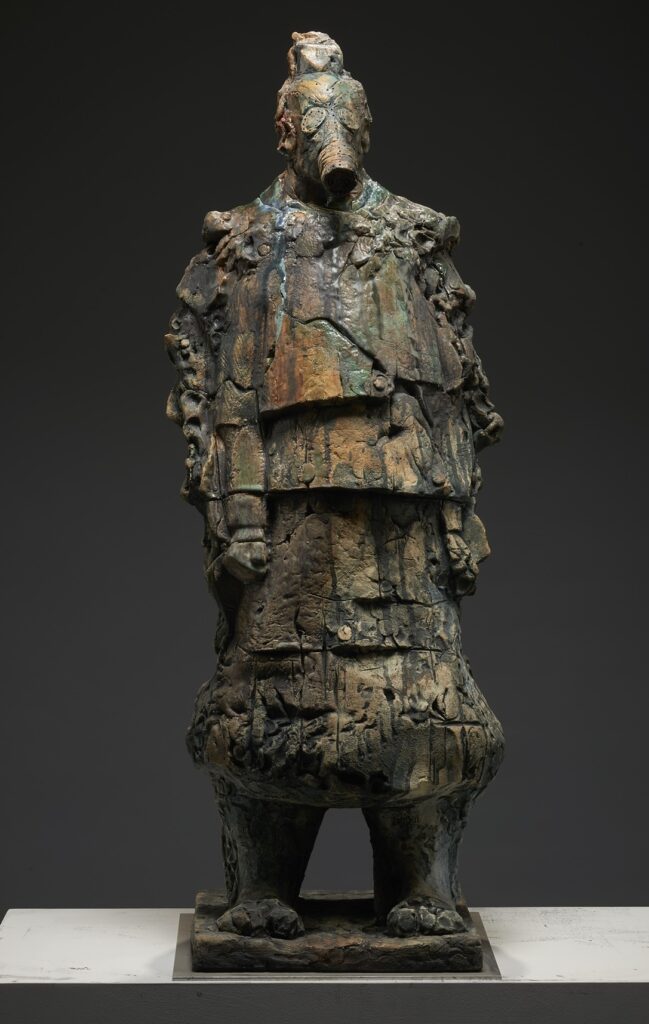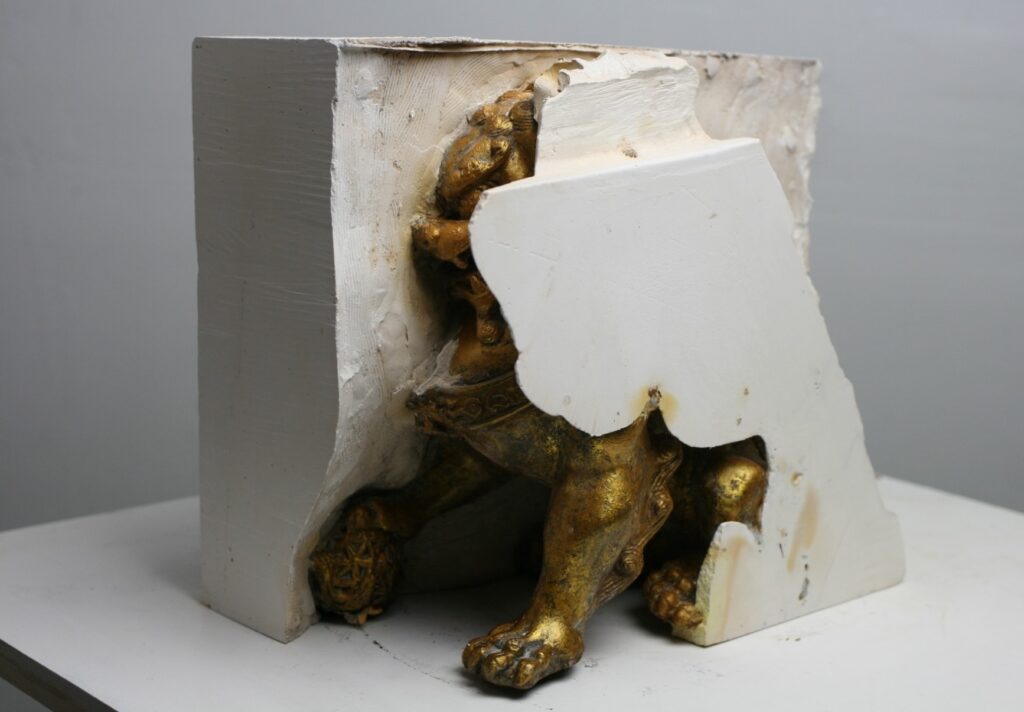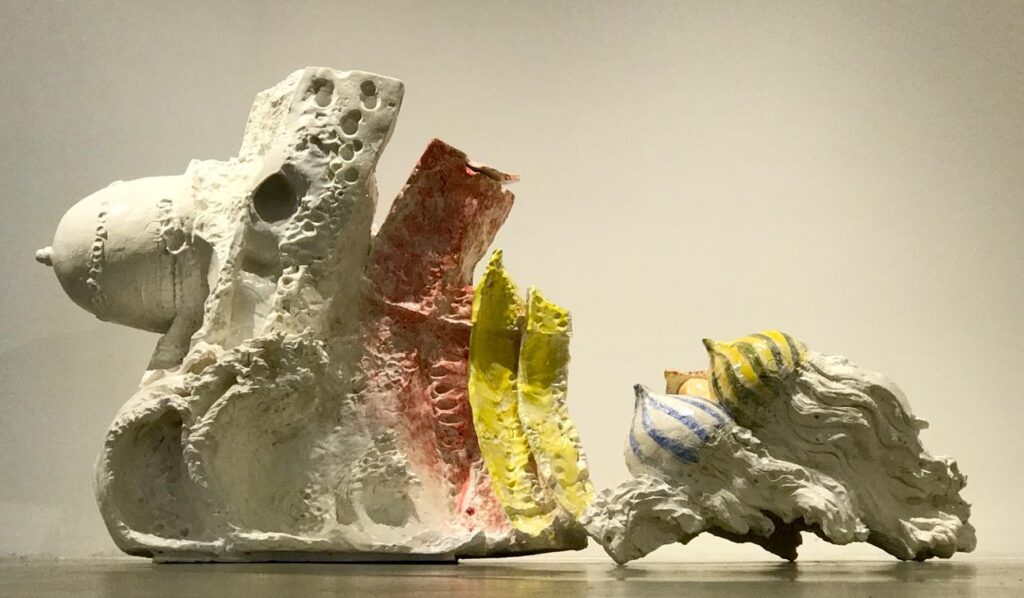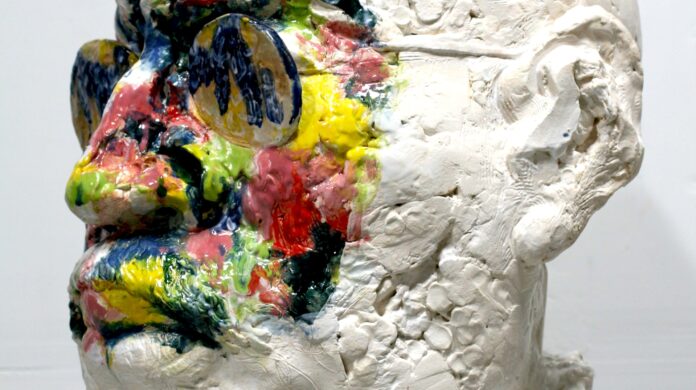“My works of art, many of which are larger-than-life size, have combined my personal life experience and social change in our community with multiple layers. My sculptures must carry messages of social and political commentary,” San Francisco artist Wanxin Zhang told 48hills.
The figurative and representational sculptures of Zhang do indeed take up a large presence, evocative of an ancient aesthetic merging with modern times. Crafted in the medium of glazed, high-fired clay, his imposing-yet-accessible figures convey his classical training and contemporary influences from the Bay Area Figurative Movement.
Zhang uses the terms like identity, soulful, and fragile—but unbreakable—to describe his work. He says his sculptures represent a marriage between history and present-day cultural context. This synchronous coupling allows the artist to maintain a deep connection with where he is from and where he has chosen to go.
Zhang was born in Changchun, China in 1961 and was of the country’s first generation to receive a formal art education in college after the Cultural Revolution ended in 1976. In 1985, he graduated with a BFA from the Lu Xun Academy of Fine Art with a degree in sculpture. (The academy was founded in 1938 as Luxun Academy of Arts by Chinese Communist Party leaders, including Mao Zedong and Zhou Enlai, in Yan’an, Shaanxi Province.) In 1992, at the age of 31, Zhang immigrated to the United States, pursued MFA studies in San Francisco, and completed his degree at the Academy of Art University in 1996.

As a college student in China, he viewed an exhibition of the excavated Terra Cotta Warriors. The thousands of clay soldiers that once guarded the tomb of Qin Shi Huang, first emperor to China have been a profound and long-lasting point of reference for Zhang. He sensed that one day he would recreate the figures using his own vision. Over 20 years ago, in a kind of homage to his cultural heritage, Zhang began the journey of creating his own clay warriors, imbued with personalized characteristics and contemporary connotation, merging past with present.
Zhang says he lived through one of the most devastating periods of cultural destruction in modern history. He notes that upon visiting the Terra Cotta Warriors of the Qin excavations, he realized that the feudalism and oppression from the Qin dynasty had never quite left the country.
“Though the origins of my work grew from historical references, my pieces actually attempt to raise questions that endure through time. My geographical and ideological personal journey formed the opinions that now question and explore the world today with humor, confusion, anxiety, and sarcasm,” Zhang said.
What Zhang says he likes most about being part of the creative community of San Francisco is the diversity, multiculturalism, fashion, vitality, and overall inclusive society the region has to offer. Creatively speaking, Zhang is inspired by artists of every genre, from classic to contemporary, and especially resonates with California clay artists extending limits in figurative art. Having met Bay Area luminaries who altered the world of ceramics, including Robert Arneson, Viola Frey, Richard Shaw, and Stephen De Stabler, Zhang’s perspective shifted from ceramics as craft to clay as a medium for fine art.
But well before that, his first artistic influence was his mother, who encouraged him to capture in sketches what he saw in the landscape around their home as a young child. He attended art school at 16, continued his studies in college and began teaching in a local art school after graduation. Feeling conflicted about working in a classical tradition while the world progressed beyond it, he decided to come to the United States. Zhang says changing his location, changed his mind. He turned a page in his work, including a bold transition from metal to clay.
Zhang has worked as a full-time artist from his studio in the Bayview area of San Francisco for 20 years. It’s the place where he conducts all of his work and connects with friends. As an art instructor in the Bay Area, Zhang has taught at the San Francisco Art Institute, California College of the Arts, Academy of Art University, the Department of Art Practice at the University of California, Berkeley, and has served as a guest lecturer and panel member for various arts organizations. He has been the recipient of several grants and awards over the course of his career and his work is in numerous public collections across the United States and Asia.

The artist shows his work widely in both group and solo exhibitions and his work has been acquired for numerous museum permanent collections. Since 2013, Zhang has been represented by Catharine Clark Gallery, whose C South Gallery is showing his fourth solo exhibition, California Artist, Too, through January 11. Spirit House, a group show at the Cantor Arts Center at Stanford University in Palo Alto (runs through January) includes Zhang’s pink, bronze warrior sculpture titled Made in China.
Catherine Clark told 48hills that over the decade that the gallery has worked with Zhang, they have witnessed various shifts in his approach to ideas expressed through his chosen medium.
“His work ranges from humor and lighthearted observations about contemporary life and politics, to more sober themes that reflect the impact of Covid-19 on global health and international relationships, political divisions and conflict, and the heightened impact of climate change on the environment and communities least able to weather them. With the work in his new solo show, his sculptures appear to visually offer serenity and calm with glazes in light, pastel colors—a seeming call for peace in an increasingly divided and chaotic society,” Clark said.
As part of the current exhibit at the gallery, Clark says that visitors will meet a large-scale, Buddha-like wall drawing with an interactive sculptural element which collectors are invited to take with them, while at the same time leaving a piece of writing on the wall that reflects the spirit of the Meditation Series from which the piece hales.
“Zhang offers meditative clay faces as a prayer for peace in a fractured world, capturing both the desire for calm and the reality of conflict, as well as disrupting and changing the gallery presentation through the action of taking away parts of the work before the close of the exhibit. In this way, the exhibition will transform across the two months it is on view,” Clark added.
This past year, other shows include Zhang’s participation in the group exhibit, Place: Reckoning Asian American Belonging at the Institute of Contemporary Art San Jose (ICA) and M is for Water, at the di Rosa Center for Contemporary Art in Napa. His piece Waiting (2021) is included in the celebration exhibit of the Legion of Honor Fine Arts Museum in San Francisco, Legion of Honor 100, which celebrates the museum’s centennial anniversary and is running through November 18 of next year.

When asked what he hopes people will experience from his work, Zhang simply—if not cryptically—answers, “Anything, something, or nothing, it depends.”
As his gallery representative, Clark supplements by stating, “As Zhang himself is quick to say about his practice, his art is not merely an act of creation but a declaration of life itself, an opportunity to express the truths that shape our collective existence from moments of joy to times of deep self-reflection.”
An artist’s statement on his website says that Zhang elaborates on his process, potential, and personal growth as an artist since his move to the United States.
“Not only have I been able to constantly push the boundaries of what clay can express, I have also been able to really push myself to see how I can truly incorporate my purpose, inspirations, and critiques to reflect life,” he says. “To reflect the limitless boundary of the contemporary social and political messages. Most importantly, I’ve been able to utilize clay to try to represent the spirit of humanity.”
For more information, visit his website at wanxinzhang.com and on Instagram.





